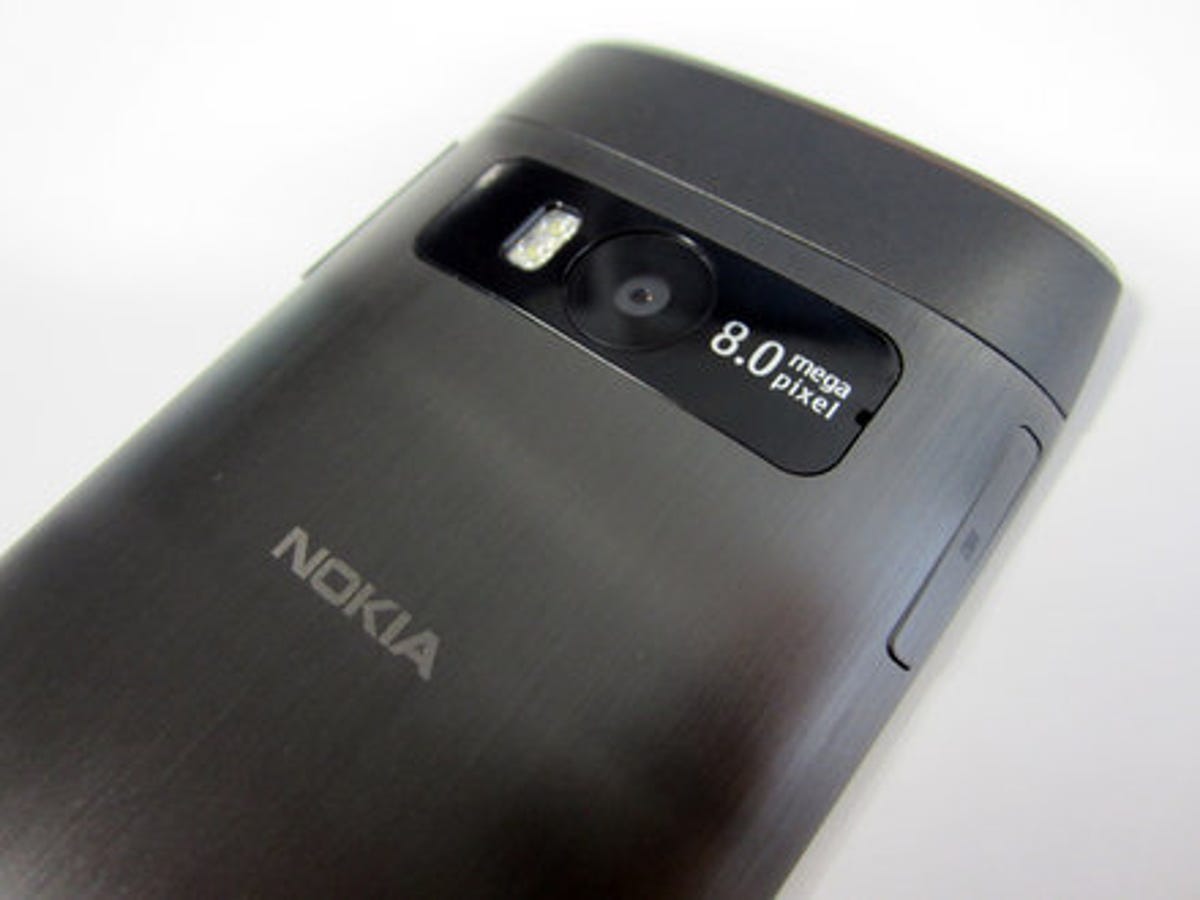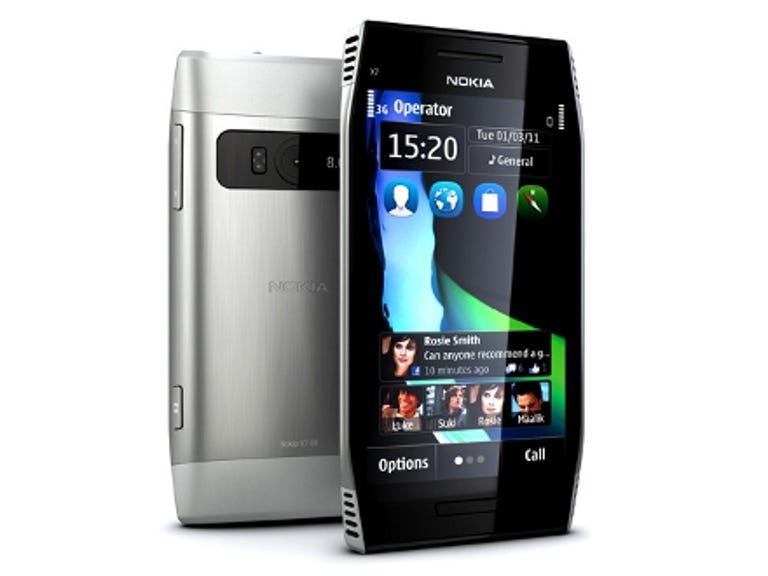 Why You Can Trust CNET
Why You Can Trust CNET Nokia X7 review: Nokia X7
The Nokia X7's exterior is a treat for the eyes, but its internal components are a different story. A weak processor and outdated Symbian operating system mean this smart phone isn't a match for the iPhone or many Android devices.
The Nokia X7 is the latest offering in the company's soon-to-be-extinct Symbian smart-phone range. Its gorgeous appearance and great build quality ensure a positive first impression, but they also mask some serious issues with the internal technology and software.
The Good
The Bad
The Bottom Line
The X7 is available for free on a monthly contract for around £30. If you want to pick up the phone SIM-free, expect to hand over around £350.
Build quality
If looks could kill, the X7 would be responsible for quite a few fatalities. The sleek metal casing and futuristic, angular styling are pretty exciting when you consider that most other phone makers seem content to just copy each other's ideas.

The cool grilles situated on each corner of the X7's front look like they belong on a high-performance sports car, and the brushed-metal back gives the handset a premium feel that even the likes of the Samsung Galaxy S2 struggle to provide.
Nokia is famed for producing devices with solid build quality, and the X7 continues this tradition. It feels as solid as a rock, and refuses to emit a single creak no matter how hard you grip its casing.
Size and weight
At just under 12mm thick, the X7 isn't the thinnest smart phone we've seen, but it won't create a massive bulge in your pocket either. At 146g, you're not going to be able to carry it around in your trousers without knowing about it.
Not every aspect of the X7's design is pleasing. There's no way of replacing the battery, which means you can't purchase an additional power cell for those long trips away from home.
The solid casing also means that Nokia has had to resort to somewhat unusual methods for inserting and removing the SIM and microSD cards. These slot into the left-hand side of the X7 via removable compartments, but the extraction process is incredibly fiddly. It also feels as if the compartments themselves could snap if you use too much force.
AMOLED screen
The X7's 4-inch AMOLED touchscreen is gorgeous, but it lags behind the more recent Super AMOLED Plus variant seen on the Galaxy S2. The resolution of 360x640 pixels is also slightly disappointing, especially when you consider the phone is a top-of-the-range handset. Even the ageing HTC Desire manages a resolution of 480x800 pixels, albeit on a slightly smaller display.
The capacitive touchscreen is reinforced by toughened Gorilla Glass. It supports multi-touch commands, such as pinch to zoom.
Symbian Anna
It's common knowledge that Nokia is putting its much-lamented Symbian OS out to pasture this year, in favour of using Microsoft's Windows Phone operating system. That effectively makes the X7, which runs Symbian Anna, the latest version of the OS, something of a dead end.
Symbian may have undergone some alterations to bring it in line with Android and Apple's iOS, but it still lags behind those two market-leading operating systems by some margin. While it gets some stuff right -- such as active home-screen widgets, revised icon grids and integration with Nokia's Ovi Store for downloads -- much of the basic functionality is highly suspect.
Processor
Just navigating the X7's menu system can be a chore, thanks to the slovenly nature of the phone's 680MHz processor. With rival phones such as the HTC Sensation and LG Optimus 2X running dual-core CPUs, it's hard to justify putting such a slow chip inside the X7.
The lack of muscle affects almost every activity you can think of -- be it playing a 3D game, watching a video or even just moving between applications. If you intend to use the X7 to the fullest of its capabilities, you'd best get used to seeing the omnipresent loading symbol.
Camera
High-resolution cameras are another Nokia trademark, and the X7 boasts one with an impressive 8-megapixel sensor. It's a fixed-focus lens, so macro shots are out of the question, but it handles everything else with ease. It's also capable of recording video in 720p high definition.
Storage and connectivity
With an 8GB microSD card included in the box, the X7 offers enough storage space to keep a modest user happy. If you're looking to pump lots of music, videos and photos onto the device, you'll want to bolster the storage space with a larger card. The X7 supports microSD cards of up to 32GB in size.
The X7 is pretty well equipped when it comes to wireless connectivity. HSPA support allows you to download data using a 3G signal, while 802.11b/g/n Wi-Fi is on hand for those times when you're in reach of a hotspot.
Web browsing
Web browsing on the handset is decent enough, but the experience falls short of that offered by many Android devices and the iPhone. Adobe Flash Lite is supported, but content doesn't always display smoothly. On the plus side, the pinch-to-zoom multi-touch gesture can be used to zoom into Web pages, making it easier to digest large amounts of text.
Battery
The X7's 1,200mAh battery is claimed to offer up to 450 hours of standby time on a 3G network, but, with modest use, you can expect that figure to be much lower. We got just over a day out of the phone, although we were arguably pushing it to its limits. Used sparingly, we dare say the X7 would last longer.
Conclusion
With the first Windows Phone-powered Nokia just around the corner, you'd have to be a pretty devoted supporter of the Finnish firm to get really excited about the X7. While its design is eye-catching and build quality remarkable, what's under the bonnet is somewhat less enticing.
Symbian Anna just isn't up to scratch, and the low-spec CPU puts the X7 in the same power class as budget Android phones like the LG Optimus Me and Samsung Galaxy Mini. When you consider that Nokia is asking substantially more for this device, such mediocre tech is unforgivable.
Edited by Charles Kloet


